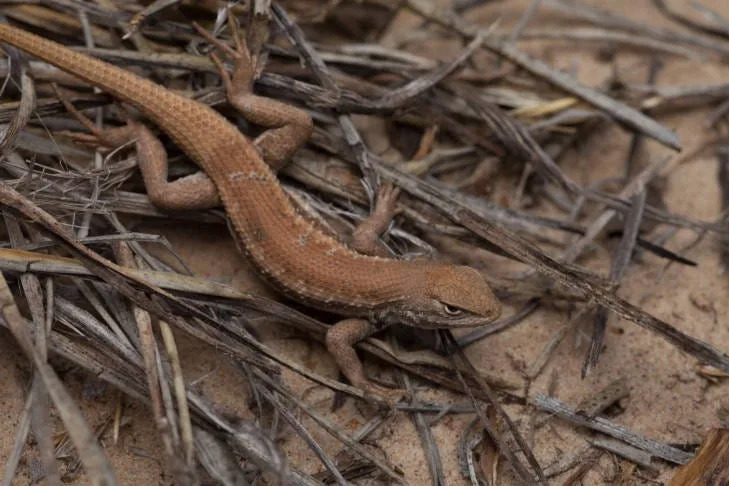- Endangered Lizard Threatens Oil and Gas Development in the Permian Basin
- The U.S. Fish and Wildlife Service listed the dunes sagebrush lizard as endangered, threatening oil and gas development in the Permian Basin.
- The oil and gas industry argues they've made conservation efforts and the lizard's habitat is minimal in the basin.
- Environmentalists see the listing as a win but worry about delayed protection and future development restrictions.
- IT'S THE OTHER WAY AROUND
A rare lizard that lives in Texas and New Mexico has become the latest potential threat to oil and gas production growth in the Permian.
The dunes sagebrush lizard was granted endangered status by the U.S. Fish and Wildlife Service last week, prompting an outcry from the industry, which warned the change in the lizard's status would be detrimental to its activity in the most prolific shale play in the country.
According to the Fish and Wildlife Service, the dunes sagebrush lizard occurs in about 4% of the lands that comprise the Permian Basin. The service also acknowledged that many oil and gas operators are already taking part in voluntary conservation efforts to preserve the species' habitat. Yet now, these appear to have been deemed insufficient, prompting a sharp response from the industry.
"We are extremely disappointed in the U.S. Fish and Wildlife Service (Service) decision to again list the Dunes Sagebrush Lizard as Endangered in the Permian Basin," the president of the Permian Basin Petroleum Association told energy analyst and consultant David Blackmon for a story published in Forbes.
"In spite of the successful conservation efforts on the ground for over a decade and that less than two years ago approving a conservation plan for the Lizard that all parties agreed would conserve habitat," he added.
The president of the U.S. Oil and Gas Association was even blunter, telling Blackmon that "Anti-energy activists have been desperate to shut down drilling in the Permian Basin for years," despite voluntary efforts and investments on the part of oil and gas operators in the area to save the rare species.
"Texas oil and gas operators spent tens of millions of dollars in voluntary conservation efforts to protect the dunes sagebrush lizard. Environmental groups meanwhile added nothing to the conservation efforts but petitions and lawsuits," Tim Stewart said.
At first glance, the reaction of the oil and gas industry may seem excessive in the context of how little of the Permian the dunes sagebrush lizard actually inhabits. But this perception may be wrong, with the Fish and Wildlife Service noting that oil and gas activity is the prime suspect for the species' "functional extinction" across almost half of its habitat.
There is also a recent example of how environmentalists can interfere with the energy industry's activities: the suspension of new liquefied natural gas export terminals that President Biden signed earlier this year was the direct result of activist pressure.
"Even if there were no further expansion of the oil and gas or sand mining industry, the existing footprint of these operations will continue to negatively affect the dunes sagebrush lizard into the future," the Fish and Wildlife Service said in its announcement and it is little wonder that the industry took this as ominous.
Even more ominously for oil and gas operators, the USFWS may yet add to its decision a designation of critical habitat for the dunes sagebrush lizard. That would be a move that, Blackmon warns, "could become extremely limiting to any future development of the massive oil and natural gas resources known to exist beneath the region."
While the energy industry fumes at the decision, environmentalists were understandably happy. "The dunes sagebrush lizard spent far too long languishing in a Pandora's box of political and administrative back and forth even as its population was in free-fall towards extinction," a regional director for Defenders of Wildlife said, as quoted by the AP.
"I'm relieved the precious dunes sagebrush lizard is finally on the path to protection," Michael Robinson, senior conservation advocate at the Center for Biological Diversity, said, as quoted by Forbes. "I'm saddened and disgusted, however, that the Service allowed the lizard's habitat to be destroyed for decades."
What follows next would become clear in two months. One thing is for sure, however. Activists will likely become bolder like they did after the LNG approval suspension. They have now focused their efforts on making sure the Federal Energy Regulatory Commission enforces new air pollution rules approved by the EPA earlier this year.
According to these rules, the maximum level of fine particulate matter in the air is now 9 micrograms per cubic meter, down from 12 micrograms previously—and FERC already tapped one LNG producer as its first target. Venture Global was recently served with a request to provide proof its particulate matter emissions were below 9 micrograms per cubic meter.
"FERC is going to have to take this issue seriously and is going to have to analyze whether these projects are in the public interest given this new reality," a Sierra Club attorney told the Financial Times.
"We plan to hold FERC's feet to the fire to ensure that it follows through and satisfies its legal obligations," Tom Gosselin also said.
One question that might be worth asking is when conservationists would become this vocal about the fate of bats and birds of prey that are being killed by onshore wind turbines and the whale deaths linked to offshore wind development.
By Irina Slav for Oilprice.com
Dunes sagebrush lizard now an endangered species
Adrian Hedden, Carlsbad Current-Argus
Thu, May 23, 2024
A lizard native to southeast New Mexico’s Permian Basin was afforded the highest level of federal protections aimed at preventing its extinction, triggering concerns that landowners and industries in the area could see added restrictions on access to the land.
The dunes sagebrush lizard was listed as endangered under the federal Endangered Species Act, per a decision issued May 17 by the U.S. Fish and Wildlife Service. An endangered listing means the agency believed extinction of the species was imminent, and requires the federal government establish and recovery plan and potential “critical habitat” where the lizard would be recovered.
This could restrict some uses of the land, namely oil and gas drilling and farming and ranching, and the move drew fears that the economic drivers of the region could be stymied for environmental conservation.
Emily Wirth, executive director of the Center for Excellence (CEHMM) said voluntary conservation practices intended to protect the lizard were underway by industry since 2008. She said candidate conservation agreements (CCAs) facilitated by CEHMM saw 3.1 million acres in New Mexico enrolled in the agreements, including 90 oil and gas companies.
Via CEHMM, enrollees moved 650 oil wells out of lizard habitat, Wirth said, aside from other wells operators moved on their own.

The dunes sagebrush lizard is a small, light brown phrynosomatid lizard (family Phrynosomatidae, genus Sceloporus). Shinnery oaks provide food, shade and a breeding ground for the Dunes sagebrush Lizard.
She said it was “disappointing” that these efforts did not prevent a listing which Wirth worried could negatively impact land access.
“I think it’s very disappointing given the conservation efforts that have been ongoing since 2008,” she said. “The biggest thing we can do for the lizard is avoidance of habitat. “The industry has proactively been doing that on their own. It’s really disappointing the conservation efforts were not taken into account.”
With said landowners and operators can still enroll in CEHMM’s contracts ahead of the listing taking effect about 30 days after the announcement, and those enrolled will face no additional restrictions.
She pointed to a previous listing of the lizard in 2012, which was overturned, Wirth said, due to the ongoing conservation efforts taken by industry.
“Nothing has changed. To me, it doesn’t really make sense for the current listing in New Mexico specifically,” Wirth said. “We’re keeping industry on the ground working in the face of a listing. They have protections. Our agreements are the perfect balance by allowing conservation and economic development on the land.”
More: White nose syndrome kills millions of bats each year. Now it's in Lincoln National Forest.
Lizard protection opposed by oil and gas industry
The decision to list the lizard came after a 90-day public comment period, and a “rigorous review” of the scientific and commercial information, read the U.S. Fish and Wildlife Service announcement. The agency said critical habitat was expected to be designated, but not at the time of the listing decision.
The lizard is found only in the shinnery oak and sand dune ecosystems in southeast New Mexico and West Texas, occurring in about 4% of the 86,000 square miles that make up the Permian Basin, read the agency’s report. Key threats to the species were oil and gas development, mining and climate change, the report read.
The Fish and Wildlife Service said about 85% of the lizard’s range are covered by voluntary enrollments in programs like CEHMM’s, noting horizontal drilling techniques can often target underground oil reserves without locating wells within lizard habitat.
Amy Lueders, southwest regional director with the Services said the federal government expected to continue working with industry and landowners to conserve the species and restore its population.
“The Endangered Species Act is an important tool in preventing the extinction of imperiled species like the dunes sagebrush lizard,” she said. “The Service will continue working collaboratively with Tribes, industry, stakeholders, and private landowners while ensuring protections for the lizard and its habitat.”
Listing the dunes sagebrush lizard as endangered was celebrated by conservation groups, arguing stronger efforts were needed to prevent extinction. Michael Robinson with the Center for Biological Diversity in Silver City said the listing decision was delayed for decades but would help save the lizard.
“After four decades of the government sitting on its hands, these lizards are finally protected from oil spills and giant machines scooping up sand,” Robinson said. “Designating critical habitat will close any loopholes that might still allow the destruction of the beautiful oak-dotted dunes where these animals live.”
The listing was opposed by oil and gas industry leaders in New Mexico. In comments submitted Oct. 2, 2023 the Independent Petroleum Association of New Mexico (IPANM) argued oil and gas was produced “responsibly” in dunes sagebrush lizard habitat, pointing to the CCAs the trade group’s member companies already participated in.
IPANM was joined by national fossil fuel groups the American Petroleum Institute and Western Energy Alliance in submitting comments against the listing when it was proposed last year.
IPANM Executive Director Jim Winchester wrote that the Fish and Wildlife Service should withdraw the listing decision as he said it would increase costs for operators, delay projects and create regulatory uncertainty for company’s operating in New Mexico.
“An endangered listing will have a significant impact on the IPANM members business planning and operations by increasing operational costs, delaying project timeframes, and limiting or precluding operations in certain areas, he wrote.
“In particular, the proposed rule makes arbitrary conclusions based on use of inaccurate habitat mapping, and significantly outdated forecasts on energy development based upon development practices no longer employed in west Texas and eastern New Mexico.”
Adrian Hedden can be reached at achedden@currentargus.com or @AdrianHedden on the social media platform X.
This article originally appeared on Carlsbad Current-Argus: Oil and gas against dunes sagebrush lizard protection in New Mexico
Texas lizard added to endangered species list over the oil and gas industry’s objections
The dunes sagebrush lizard lives in the same West Texas land that supports the state’s biggest oil and gas fields, and industry leaders say the new designation will hurt drilling and production.
BY ALEJANDRA MARTINEZ AND CARLOS NOGUERAS RAMOS
MAY 22, 2024
/https://static.texastribune.org/media/files/aaff4d69284c6b4c22ef4037503a3aab/Dunes%20Sagebrush-Lizard%20Ryan%20Hagerty%20USFWSFPWC.jpg)
ODESSA — The dunes sagebrush lizard burrows its coarse, spiny body to cool down and sometimes conserve heat way deep beneath the sand dunes in the Mescalero-Monahans ecosystem 30 miles west of this West Texas city.
But the 2.5-inch-long lizard’s home — sandy mounds studded with low-lying shinnery oak trees — is being disrupted as the oil and gas industry expands, posing a grave threat to its survival, federal regulators and scientists said.
After four decades of warnings by biologists about the existential threat that oil and gas exploration and development poses on the reptile’s habitat, the U.S. Fish and Wildlife Service declared the rare lizard endangered last week.
Industry representatives have for years fought against the designation saying it would scare off companies interested in drilling inside the nation’s most lucrative oil and natural gas basin.
The listing requires oil and gas companies to avoid operating in areas the lizard inhabits, but the Fish and Wildlife Service has yet to determine where those areas are because it is still gathering information, according to Beth Ullenberg, a spokesperson for the Service.
Should the energy industry encroach on the lizard’s habitat, they could incur fines up to $50,000 and prison time, depending on the violation. However, Ullenberg said the agency would work with companies to avoid penalties.
In a statement, the Fish and Wildlife Service said oil and gas operators can use horizontal drilling to reach oil and gas deposits without disrupting the lizard’s habitat.
The lizard only lives in about 4% of the 86,000-square-mile Permian Basin, which spans across Texas and New Mexico, according to the Fish and Wildlife Service. In Texas, the lizard has been found in Andrews, Crane, Gaines, Ward and Winkler counties.
Lee Fitzgerald, a professor at Texas A&M University who has studied the lizard since 1994, said that drilling a single oil well does not impact the lizard’s survival, but the fragmentation of its habitat by the oil and gas industry’s infrastructure — including the roads leading to drill sites — isolates the reptiles and prevents them from finding mates beyond those already living close by.
Fitzgerald compared the oil and gas infrastructure to urban sprawl.
“If you build one house, it's not a problem,” he said. “But you build 1,000 houses, and every one of them has a driveway, and every one of them has a street, connecting it to more houses then you get urban sprawl. And if you do that in the shinnery oak sand dunes then the lizards disappear.”
There are few remaining lizards and they are hard to find, making it difficult to count them accurately. According to a 2023 analysis by the Fish and Wildlife Service, the lizards are “functionally extinct” across 47% of its range.
Fitzgerald said the population estimates of the lizard don’t matter.
“The lizard is just one piece of the puzzle that is disappearing,” he said. “It's out there, it's alive. We should be proud of it, that we have it, and it's so special. So, it's more about the non-monetary values of the lizard as it is part of the big picture of biodiversity.”
Listing could cause disruption in oil production
The decision to categorize the lizard as a species in danger of extinction was unwelcome news for oil and gas industry leaders, who said federal regulators provided insufficient guidance for operators to evaluate how to decide where to build service roads and where to drill. Members of the industry also said they’re skeptical of the science supporting the designation.
“I think that the lizard is not in danger of extinction,” said Ben Shepperd, president of the Permian Basin Petroleum Association.
The ramifications of the listing won’t be immediate, but it could have lasting impacts on the future of oil and gas extraction, Shepperd said, adding that it could affect a company’s ability to drill without running afoul of federal requirements under the Endangered Species Act.
“Not overnight, but over the coming months, we believe that that's going to lead to a decrease in drilling. We believe it's going to lead to … job losses,” Shepperd said.
In a joint statement with the Texas Oil and Gas Association, delivered to the federal agency last year, energy industry leaders argued that oil and gas companies were already taking measures to prevent further disturbing the lizard’s habitat: a 200-meter buffer between their operations and the lizard’s home, minimizing their presence in the area and using existing service roads as opposed to building more.
Industry representatives also said that oil and gas companies had been participating in voluntary conservation agreements, a program in which companies and private landowners pledge to protect the lizard’s habitat. Environmentalists have criticized the agreements because there is no enforcement or penalties if companies do not comply — or a way to determine whether the plans are effective.
State and nationwide oil and gas associations have not ruled out litigation, Shepperd said.
Scott Lauermann, a spokesperson for the American Petroleum Institute, said the decision could delay the permits that companies need for every phase of oil and gas exploration and extraction.
Such permits could authorize companies to build the infrastructure necessary to pump oil like oil rigs and service roads. Federal officials encouraged companies to consult the agency early in their planning.
The lizard wars
Ten generations of lizards have lived and died while a battle ensued between environmental groups, the oil and gas industry and the federal government over their protection.
Fish and Wildlife first identified the dunes sagebrush lizard as needing protection in 1982. Since then, it has been removed and added multiple times from the candidate list for endangered species, but the proposals fell through because the Fish and Wildlife Service said it could not afford to evaluate whether the lizard should have been placed on the list, said Michael Robinson, a senior conservation advocate at the Center for Biological Diversity. The Center has petitioned and sued the Fish and Wildlife Service several times over almost two decades regarding the lizard.
In 2002, the center delivered a scientific petition to the Fish and Wildlife Service, asking the agency to add the lizard to the endangered species list. The Service did not act, citing a lack of resources, Robinson said.
The Service proposed adding the lizard to the endangered species list again in 2010 but withdrew the proposal 18 months later.
Instead, then-Texas Comptroller Susan Combs assembled voluntary conservation agreements — a pledge by landowners and operators to avoid activities like removing shinnery oak trees and building roads — to convince the federal government to avoid listing the lizard as endangered, a decision that drew praise from the oil and gas industry and rebuke from environmentalists and wildlife conservation groups.
State and federal officials argued the move would be enough to protect the lizard. More than 200 ranchers and oil and gas companies between Texas and New Mexico, federal officials said.
Shepperd said that among them were Chevron, ExxonMobil and Occidental Petroleum.
Robinson argued that the agreements shielded the oil and gas industry from making modest changes to their daily operations.
“It’s a sad case of a federal agency that has been captured by the industries they’re supposed to hold to account,” Robinson said.
In 2018, the Center for Biological Diversity petitioned again for the lizard’s protection. In 2022, the Center sued the Fish and Wildlife Service again, a lawsuit that resulted in a settlement agreement, which led to another proposal to add the lizard to the endangered species list.
Ullenberg, the Fish and Wildlife Service spokesperson, said that petition prompted the agency to conduct a review of the species and ultimately add it to the endangered list last week.
Robinson said it's an important first step.
“At least the government’s attention will be focused on the project of [recovering] the species, and that’s no small thing,” he said.
Disclosure: Ben Shepperd, Exxon Mobil Corporation, Permian Basin Petroleum Association and Texas A&M University have been financial supporters of The Texas Tribune, a nonprofit, nonpartisan news organization that is funded in part by donations from members, foundations and corporate sponsors. Financial supporters play no role in the Tribune's journalism. Find a complete list of them here.
Information about the authors
/https://static.texastribune.org/media/profiles/2022_Alejandra_Martinez_2x3.jpeg)
Alejandra Martinez
ENVIRONMENTAL REPORTER
alejandra.martinez@texastribune.org
@alereports
/https://static.texastribune.org/media/profiles/Carlos_Nogueras_Ramos_TT_crop_01.jpg)
Carlos Nogueras Ramos
PERMIAN BASIN REPORTER
carlos.nogueras@texastribune.org
@criacuervosvibe









